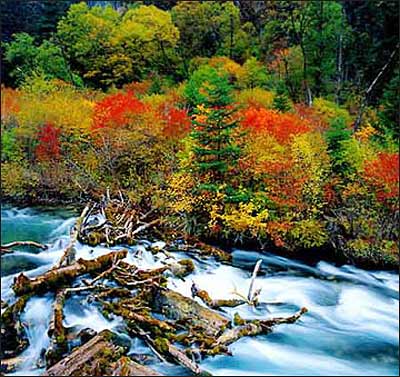The "Historic Center of Macao," China's only 2005 submission for
World Heritage listing, was approved at the 29th session of the
World Heritage Committee of the United Nations Educational,
Scientific and Cultural Organization (UNESCO). With 20 historic
buildings around the old quarter, joined up by interlacing squares
and streets, Macao's historic center has the biggest,
best-preserved and most complete concentration of Chinese and
Western buildings than any district in China. Over four centuries
of cultural exchange between China and the Western world are
represented in this jewel.
Since it joined the Convention Concerning the Protection of the
Cultural and Natural Heritage in 1985, China now has 31 world
heritage sites, ranking third in the world. Since 2004, massive
renovations have been made to Beijing's six cultural heritage sites
Ðthe Ming Tombs, Great Wall, Forbidden City, Temple of Heaven,
Summer Palace and Peking Man Site at Zhoukoudian, all of which are
planned for completion by 2008.
 |
In additon, China also has a rich non-material cultural
heritage, one of the world's richest. Its kunqu Opera, and the art
of playing the guqin (seven-stringed zither), Uygur Muqam music and
Mongolian pastoral song have been included on the UNESCO list of
Masterpieces of the Oral and Intangible Heritage of Humanity. In
2005, China, for the first time, submitted a joint application with
another country (Mongolia) for Mongolian pastoral song to be
entered on the list. The ancient Naxi Dongba literature manuscripts
and the list of successful candidates in the Qing Dynasty imperial
examinations have also been inscribed on the Memory of the World.
In 2001, the Chinese Tibetan epic King Gesar, the world's longest
epic, was listed by UNESCO in the world millennium memorials.
China's World Cultural and Natural
Heritage Sites
1. The Great Wall (Beijing, 1987, World Cultural
Heritage)
2. The Imperial Palace of the Ming and Qing Dynasties (World
cultural Heritage: the Forbidden City, Beijing, 1987;
the Imperial Palace of the Qing Dynasty in Shenyang, Liaoning
Province, 2004)
3. "Peking Man" Site at Zhoukoudian (Beijing, 1987, World
Cultural Heritage)
4. Mogao Grottoes at Dunhuang (Gansu Province, 1987,
World Cultural Heritage)
5. Qin Shi Huang Mausoleum and the Qin Terracotta
Warriors and Horses (Shaanxi Province, 1987, World
Cultural Heritage)
6. Mount Taishan (Shandong Province, 1987, World
Cultural and Natural Heritage)
7. Mount Huangshan (Anhui Province, 1990, World Cultural
and Natural Heritage)
8. Jiuzhaigou Valley (Sichuan Province, 1992, World Natural
Heritage)
9. Huanglongsi Scenic Spot (Sichuan Province, 1992,
World Natural Heritage)
10. Wulingyuan Scenic Spot (Hunan Province, 1992, World Natural
Heritage)
11. Chengde Mountain Summer Resort and Eight Outer Temples
(Hebei Province, 1994, World Cultural Heritage)
12. Potala Palace (Tibet Autonomous Region, 1994, World
Cultural Heritage)
13. Confucius Temple, Confucius Family Mansion and Confucius
Woods at Qufu (Shandong Province, 1994, World Cultural
Heritage)
14. Ancient Buildings on Mount Wudang (Hubei Province, 1994,
World Cultural Heritage)
15. Mount Lushan (Jiangxi Province, 1996, World Cultural
Heritage)
16. Mount Emei and the Leshan Giant Buddha (Sichuan Province,
1996, World Cultural and Natural Heritage)
17. Ancient City of Pingyao (Shanxi Province, 1997, World
Cultural Heritage)
18. Suzhou Classical Gardens (Jiangsu Province, 1997, World
Cultural Heritage)
19. Ancient City of Lijiang (Yunan Province, 1997, World
Cultural Heritage)
20. The Summer Palace (Beijing, 1998, World Cultural
Heritage)
21. The Temple of Heaven (Beijing, 1998, World Cultural
Heritage)
22. Mount Wuyi (Fujian Province, 1999, World Cultural and
Natural Heritage)
23. Dazu Grottoes (Chongqing, 1999, World Cultural
Heritage)
24. Ming and Qing Imperial Mausoleums (World Cultural
Heritage: Ming Xianling Mausoleums, Hubei Province, 2000; Qing
Dongling Mausoleums and Qing Xiling Mausoleums, Hebei
Province, 2000; Ming Tombs, Beijing, 2003; Ming Xiaoling
Mausoleums, Jiangsu, 2003; three imperial mausoleums of Shengjing,
Liaoning Province, 2004)
25. Longmen Grottoes (Henan Province, 2000, World Cultural
Heritage)
26. Mount Qingcheng and Dujiang Dam (Sichuan Province, 2000, World
Cultural Heritage)
27. Xidi and Hongcun--Ancient Villages in South Anhui (Anhui
Provicne, 2000, World Cultural Heritage)
28. Yungang Grottoes (Shanxi Province, 2001, World Cultural
Heritage)
29. Three Parallel Rivers Scene (Yunan Province, 2003, World
Natural Heritage)
30 The Capital Cities and Tombs of the Ancient Koguryo
Kingdom (Liaoning and Jilin Provinces, 2004, World Natural
Heritage)
31. Historic Center of Macao (Macao Special Administrative
Region, 2005, World Cultural Heritage)